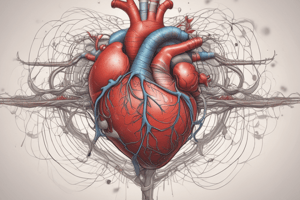Podcast
Questions and Answers
Which protein is the primary component of microfilaments?
Which protein is the primary component of microfilaments?
- Actin (correct)
- Myosin
- Tubulin
- Keratin
Myosin is responsible for muscle contraction.
Myosin is responsible for muscle contraction.
True (A)
What is the primary function of microtubules in cell division?
What is the primary function of microtubules in cell division?
pull chromosomes away from each other
Intermediate filaments are made up of long fibrous subunits of a protein called ____.
Intermediate filaments are made up of long fibrous subunits of a protein called ____.
What are the two major parts of a typical cell?
What are the two major parts of a typical cell?
What is the function of the Endoplasmic Reticulum in a cell?
What is the function of the Endoplasmic Reticulum in a cell?
Chromatin in a cell can exist in two forms, euchromatin and heterochromatin.
Chromatin in a cell can exist in two forms, euchromatin and heterochromatin.
The ____________ of a cell plays a critical role in maintaining structural integrity and providing support.
The ____________ of a cell plays a critical role in maintaining structural integrity and providing support.
Match the organelles with their functions:
Match the organelles with their functions:
Flashcards are hidden until you start studying
Study Notes
Cell Structure and Function
- The cell is the basic living unit of the body, with approximately 100 trillion cells in the human body.
- Cells are capable of reproducing, and almost all have the ability to perform specific functions.
- The cell is surrounded by a plasma membrane, which separates the cell's internal structures from the extracellular environment.
Cell Organisation
- A typical cell has two major parts: the nucleus and the cytoplasm.
- The nucleus is separated from the cytoplasm by the nuclear membrane.
- The cytoplasm is separated from the surrounding fluid by the plasma membrane.
Cell Components
- Protoplasm is a collective term for the different substances that make up the cell, including:
- Water
- Ions
- Proteins
- Carbohydrates
- Lipids
Cell Membrane
- The cell membrane is a selectively permeable structure that:
- Surrounds the cell and gives it form
- Separates the cell's internal structures from the extracellular environment
- Participates in intercellular communication
- The cell membrane is composed primarily of phospholipids and proteins.
- Phospholipids are polar (hydrophilic) and nonpolar (hydrophobic).
- The hydrophobic parts of the molecules are packed in the center of the membrane, leaving the polar parts exposed to water on both surfaces, resulting in the formation of a double layer of phospholipids.
Cytoplasm and Organelles
- The cytoplasm is the aqueous content of a cell.
- Organelles are subcellular structures within the cytoplasm that perform specific functions.
- The cytosol is the fluid portion of the cytoplasm.
- The cytosol is a highly organized structure in which protein fibers are arranged in a complex latticework surrounding the membrane-bound organelles.
Organelles
- Endoplasmic Reticulum (ER):
- A system of membranes that performs specific functions
- Two types: granular (rough) and agranular (smooth)
- Granular ER bears ribosomes on its surface and is involved in protein synthesis and secretion
- Agranular ER is involved in lipid synthesis, Ca2+ regulation, and detoxification
- Golgi Complex:
- A stack of flattened sacs with cavities called cisternae
- One side of the stack faces the ER, and the other side faces the plasma membrane
- Involved in the modification and packaging of cellular products
- Lysosomes:
- Membrane-bound organelles that contain digestive enzymes
- Primary lysosomes contain only digestive enzymes
- Secondary lysosomes contain partially digested remnants of other organelles and ingested organic material
- Residual bodies contain undigested wastes
- Peroxisomes:
- Membrane-enclosed organelles that contain specific enzymes that promote oxidative reactions
- Involved in lipid metabolism, chemical detoxification, and the breakdown of toxic molecules
- Mitochondria:
- Organelles that serve as sites for energy production
- Vary in size and shape, but have the same basic structure
- Contain their own DNA and are able to reproduce themselves
- Have a double membrane with the inner membrane folded into cristae
- Ribosomes:
- The site of protein synthesis
- Consist of two subunits that are designated 30S and 50S
- Contain ribosomal RNA and proteins
- Nucleus:
- The largest organelle in the cell
- Contains the DNA that directs the cell's activities
- Has one or more nucleoli that are centers for the production of ribosomes
- Chromatin:
- The DNA within the cell nucleus is combined with protein to form chromatin
- The threadlike material that makes up the chromosomes
- Histone proteins are positively charged and organized to form spools, about which the negatively charged strands of DNA are wound
- Cytoskeleton:
- A group of fibrous proteins that provide structural support for cells
- Consists of microfilaments, intermediate filaments, and microtubules
- Important for cell motility, cell reproduction, and transportation of substances within the cell
Studying That Suits You
Use AI to generate personalized quizzes and flashcards to suit your learning preferences.




